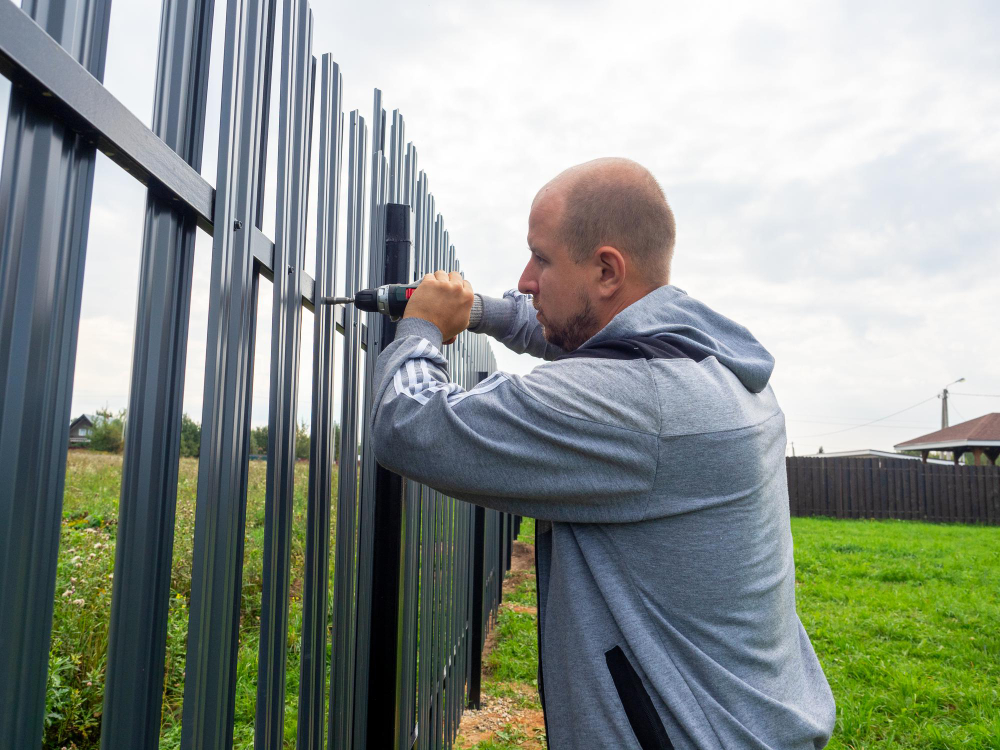
As homeowners look to enhance their property boundaries and cultivate privacy, the question of cost often arises when considering fence installation. Understanding the potential expenses of installing a fence in 2025 can help homeowners make informed and budget effective decisions. This guide will explore various factors that influence fencing costs, including materials, labor, and location, and provide estimates to help you prepare financially for your fencing project.
Average Fence Installation Costs
The materials you choose for your fence and the size of your yard affect the total cost of installation. On average, fence installation costs around $4,000 nationwide. Basic projects can start at $1,000, while more extensive ones can cost up to $7,000. These costs typically include:
- Wood or vinyl fences cost between $20 and $60 per linear foot.
- A privacy fence typically costs $25 to $60 per linear foot.
- Picket fences generally fall between $20 and $50 per linear foot.
- Replacing a fence usually costs about $30 to $80 per linear foot.
Factors That Impact Fence Installation Cost
The cost of installing fence panels isn’t something that can be easily estimated as there are so many things that can impact your price. Such as:
Fence Materials
Choosing the right materials for your fence is crucial during the planning and construction stages. The materials influence the fence’s appearance, functionality, and overall cost. Different types of materials offer distinct benefits and pricing. Below are some frequently used fence materials along with their associated costs:
| Fence Material | Cost in per linear foot |
| Wire | $1–$7 |
| Bamboo | $6–$12 |
| Wood | $17–$22 |
| Chainlink | $9–$30 |
| Vinyl | $15–$30 |
| Steel | $17-$90 |
| Composite | $23–$37 |
| Aluminum | $30–$50 |
| Wrought Iron | $24–$44 |
Bamboo Fencing: A sustainable option that adds a natural look, bamboo is durable and provides good privacy.
Wood Fencing: A classic choice that balances looks, privacy, and cost. It’s easy to install and customize.
Chainlink Fencing: A strong and affordable solution for security, especially if privacy isn’t a concern.
Vinyl Fencing: A premium choice that lasts long and requires little maintenance. It’s durable and weather-resistant, ideal for those willing to spend more.
Composite Fencing: Made from plastic and wood, composite fences look like wood but are more durable and easier to maintain.
Aluminum Fencing: Lightweight and rust-proof, aluminum fences come in various styles and need minimal maintenance.
Wrought Iron Fencing: Expensive but elegant, wrought iron fences are strong and stylish, offering customization options.
Fence Size & Height
The size of the area you want to fence and the height of the fence affect your installation costs. A larger area means higher material and labor costs. For example, installing a wood fence costs about $10 to $45 per linear foot. If your fence is about 100 linear feet, expect to spend between $1,000 and $4,500. Fences usually range from 6 to 8 feet tall, so opting for a shorter fence can reduce costs.
Labor
To get a precise estimate for your fence installation, include labor costs. The high-quality materials you chose won’t be installed without help. Labor rates usually range from $30 to $100 per hour depending on several factors, such as:
Local Labor Rates: Labor costs vary by region and generally relate to living costs—areas with higher living costs tend to have higher labor rates.
Skill Level: An experienced fence contractor usually charges more than a beginner.
Installation Complexity: Labor costs may rise if your property is sloped, has complicated features, or needs custom solutions.
Fence Complexity
Installing a fence can become more expensive if you choose complex designs. For instance, adding a gate usually requires more materials and labor, costing between $400 and $1,200, depending on its size and design. Additionally, building a fence in a sloped or uneven yard will be more expensive than on a flat surface.
Custom Features
Upgrading fences with better security and unique materials will increase costs. For instance, adding motion sensor lights can cost $50 to $100 each. Custom colors and designs from painting or staining can add $3.50 to $13 per linear foot.
Location
Where you live affects fencing costs. Labor rates and material prices vary by State. Usually, fence contractors in the U.S. charge around $50 per hour. For an accurate estimate, talk to local contractors.
Additional Cost Considerations
Removing large debris like shrubs or trees or removing a fence will increase costs. Also, check if you need a fence permit before starting the project. If permits are needed, your contractor can add the permit fee, which is typically $20 to $60, to your total estimate. There are a few additional costs to keep in mind:
Permits & Inspections
Check if you need a permit and inspection for your fence, which can add to the cost.
Site Preparation
If your yard is uneven, factor in the cost of levelling it.
Gates & Accessories
Budget for any gates, hardware, or decorative features you want.
Maintenance & Repairs
Some fence materials require more maintenance and repairs, increasing long-term costs.
Tips to Save Money on Fence Installation
Managing costs is vital for a fencing project. Here are some simple ways to save money without sacrificing quality:
- Choose Affordable Materials: Use economical picket or woven fencing. While metal is more expensive upfront, it lasts longer and can be a better investment in the long run.
- Plan Your Schedule: Try to do your project in off-peak times when contractors may charge less, which can help reduce labor costs.
- Get Multiple Quotes: Always ask for at least three quotes from local contractors. This allows you to compare prices and negotiate, minimizing overspending on installation.
- Buy In Bulk: Buying materials in larger amounts often comes with discounts. Purchasing more wooden or uPVC panels can significantly lower the cost per panel.
- Reuse Old Materials: If your current fence has parts that can be reused, consider using them. This will help you save money and reduce waste disposal costs.
Using these tips, you can keep your fencing project within budget while still getting what you want.
Benefits of Hiring a Professional
When installing a new fence for your property, trying to save as much money as possible can be tempting. However, a DIY approach can often end up costing more than hiring a professional in the first place. There are several benefits of hiring professional contractors to handle your needs – both short and long term:
Cost Savings
Avoids High Equipment Costs: Utilizing expert services can eliminate the need to rent or purchase expensive construction equipment, reducing overall project expenses.
Competitive Pricing for Quality Materials: Professionals often have access to high-quality materials at competitive prices, ensuring better value for your investment.
Transportation Cost Reduction: Service providers can help minimize transportation costs by sourcing materials locally or managing logistics efficiently.
Quality Installation
- Legal Compliance Assurance: Professionals ensure all installation and construction work is completed according to local laws and regulations.
- Mistake Prevention: Hiring experts helps avoid costly errors, such as damaging buried utility cables or pipes, which can lead to significant repair costs.
- Guaranteed Quality: Many contractors offer warranties and guarantees for their work, providing peace of mind with long-lasting results.
Time Savings
- Efficient Project Completion: Professionals can complete projects efficiently, ensuring timely execution without sacrificing quality.
- Accurate Time and Resource Estimates: Experienced contractors can provide realistic timelines and resource needs, helping you plan better.
- Quick Problem Resolution: Professionals are equipped to respond promptly to any issues during the project, minimizing delays.
Expert Advice
- Material Selection Guidance: Professionals can help you choose the best materials for your budget, design preferences, and functional requirements.
- Weather-Resistant Recommendations: Experts can recommend materials that can withstand local weather conditions, enhancing the durability of your project.
Local Support
- Personalized Local Service: Working with local contractors often ensures a more personalized approach and a strong commitment to customer satisfaction.
- Economic Contribution: Hiring locally supports the community’s economy by keeping jobs and resources in the area.
Compliance
- Regulatory Adherence: Professionals ensure their work meets all necessary regulations and standards for your area.
- Understanding Local Requirements: Local contractors are familiar with the specific requirements and regulations affecting your project site, ensuring compliance and avoiding potential setbacks.
Conclusion
Understanding the potential costs of fence installation in 2025 is essential for homeowners and property developers. With factors such as material prices, labor costs, and economic conditions continually changing, it’s advisable to plan in advance. By conducting thorough research and budgeting accordingly, you can ensure you are prepared for the investment needed to enhance your property with the right fencing solution.


